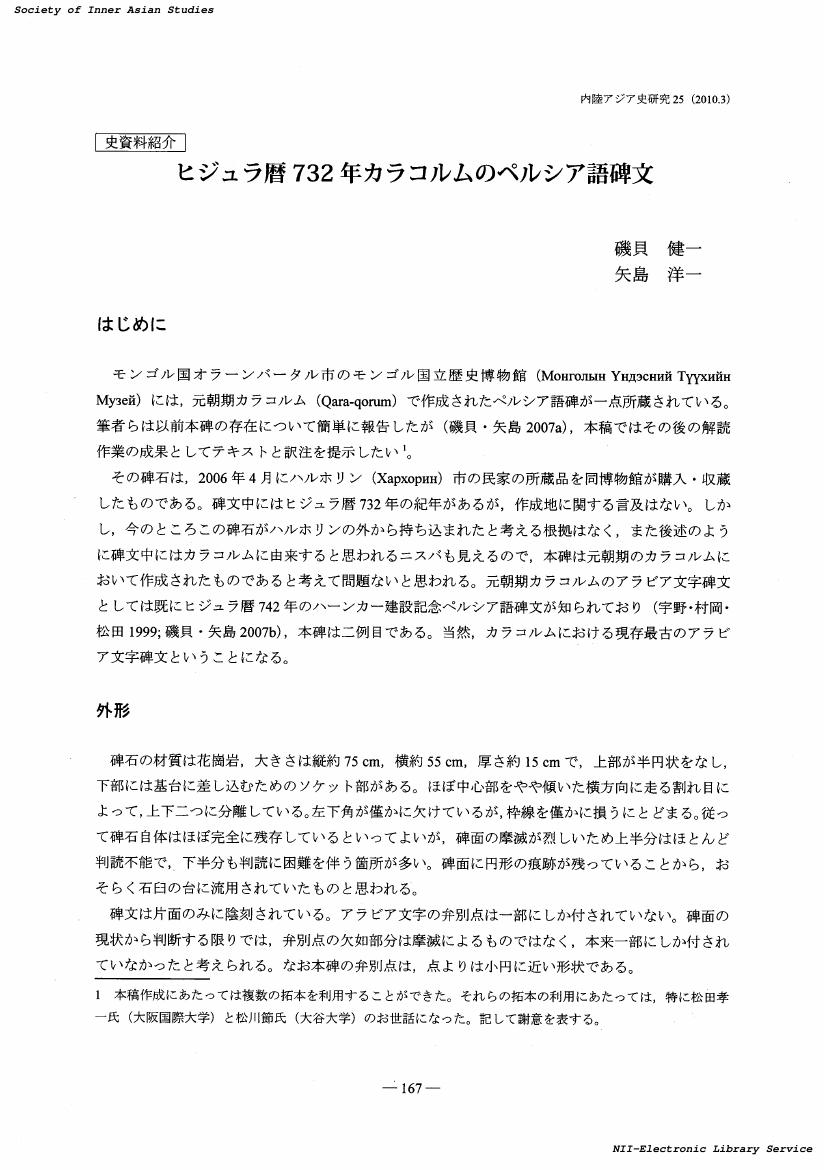- 著者
- 赤木 崇敏
- 出版者
- 内陸アジア史学会
- 雑誌
- 内陸アジア史研究 (ISSN:09118993)
- 巻号頁・発行日
- vol.25, pp.217-218, 2010-03-31 (Released:2017-10-10)
1 0 0 0 OA 雲南省麗江に残る漢文化伝播の痕跡を訪ねて : 清代改土帰流と麗江古城の形成(紀行)
- 著者
- 山田 勅之
- 出版者
- 内陸アジア史学会
- 雑誌
- 内陸アジア史研究 (ISSN:09118993)
- 巻号頁・発行日
- vol.25, pp.179-187, 2010-03-31 (Released:2017-10-10)
1 0 0 0 OA ヒジュラ暦732年カラコルムのペルシア語碑文(史資料紹介)
- 著者
- 磯貝 健一 矢島 洋一
- 出版者
- 内陸アジア史学会
- 雑誌
- 内陸アジア史研究 (ISSN:09118993)
- 巻号頁・発行日
- vol.25, pp.167-177, 2010-03-31 (Released:2017-10-10)
1 0 0 0 OA 「満洲国」興安総署菊竹実蔵次長の辞職について : 『片倉衷文書』の分析から
- 著者
- 胡日査
- 出版者
- 内陸アジア史学会
- 雑誌
- 内陸アジア史研究 (ISSN:09118993)
- 巻号頁・発行日
- vol.25, pp.143-165, 2010-03-31 (Released:2017-10-10)
KIKUTAKE Jitsuzo (1889-1946), a policy maker for Mongolian affairs in the early "Manchukuo" era, assumed vice directorship of the Xing'an Bureau (Xing'anju) on June 1, 1932 and resigned as vice director of the Xing'an Office (Xing'an Zongshu) on December 19, 1933. Unfortunately, no comprehensive study on the cause of his resignation has been made to date. Through analyzing primary sources in the KATAKURA Tadashi Collection, the author came to a conclusion that KIKUTAKE's resignation can be ascribed to the disagreement over the dismissal of OZAWA Iroha, the supervisor of the Darqan Banner police, in a discord within the "Manchukuo" government over how to rule the Mongols. The author also tries to elucidate actions taken by KATAKURA and KIKUTAKE, after the latter resigned from the office and attempted to make a comeback in politics of "Manchukuo."
- 著者
- 大出 尚子
- 出版者
- 内陸アジア史学会
- 雑誌
- 内陸アジア史研究 (ISSN:09118993)
- 巻号頁・発行日
- vol.25, pp.121-142, 2010-03-31 (Released:2017-10-10)
This paper examines the history of the National Museum of "Manchukuo" in terms of both political and scientific histories. The possession of the National Museum was initially comprised of three distinctive collections: property of the former Qing court, cultural artifacts of Chinese civilization, and excavated items. Over the years, however, the items in display changed. The scientific results of the Far Eastern Archaeological Society began to be reflected in the National Museum's exhibits, so the cultural artifacts of the Koguryo, Bohai, and Liao dynasties began to be featured prominently. The archaeological surveys conducted in the northeastern region of China at that time were intended to give substance to the history of "Manchukuo." In "Manchukuo," archaeological surveys of Bohai were given priority, because its exchanges with Japan could be historically confirmed this way. Furthermore, as the heartland of the Liao Dynasty situated in the region occupied by the Kwantung Army in the Battle of Rehe, archaeological results that would create the history of "Manchukuo" were expected from the survey. The exhibits of the National Museum reflecting the, excavation surveys conducted in line with the aforementioned political agendas were the exhibits that served to deliberately create the "Manchurian characteristics."
1 0 0 0 OA 日本に現存するマニ教絵画の発見とその歴史的背景(特別寄稿)
- 著者
- 森安 孝夫
- 出版者
- 内陸アジア史学会
- 雑誌
- 内陸アジア史研究 (ISSN:09118993)
- 巻号頁・発行日
- vol.25, pp.1-29, 2010-03-31 (Released:2017-10-10)
Comparing with a Manichaean silk-painting at Yamato-bunkakan (Nara, Japan) studied by YOSHIDA Yutaka and basing on the historical background, I have identified another silk-painting at Seiunji temple (Yamanashi prefecture) as an image of the Manichaean Jesus. The latter was first introduced as a Nestorian image by IZUMI Takeo in his article published in 2006. Soon after its publication, however, Dr. Zs. GULACSI and I have independently arrived at the same conclusion that it should be regarded as the Manichaean Jesus. Contrary to her article made from an art-historical point of view, I have mainly discussed a history of the Manichaeans who survived in southern China since the ninth century. We are now able to affirm that at least seven Manichaean paintings are preserved in Japan, and that they were mixed up with paintings generically known as Song and Yuan Buddhist paintings produced chiefly in southern China. Basing on this fact, I have proposed a new interpretation of the bilingual epitaph in Syro-Turkic and Chinese dating from 1313 unearthed at Quanzhou as well as a revaluation of the account on an unknown religion in Fuzhou described by Marco Polo.
1 0 0 0 OA 編集後記
- 出版者
- 内陸アジア史学会
- 雑誌
- 内陸アジア史研究 (ISSN:09118993)
- 巻号頁・発行日
- vol.24, pp.App1, 2009-03-31 (Released:2017-10-10)
- 著者
- 濱田 正美
- 出版者
- 内陸アジア史学会
- 雑誌
- 内陸アジア史研究 (ISSN:09118993)
- 巻号頁・発行日
- vol.24, pp.180, 2009-03-31 (Released:2017-10-10)
- 著者
- 青木 雅浩
- 出版者
- 内陸アジア史学会
- 雑誌
- 内陸アジア史研究 (ISSN:09118993)
- 巻号頁・発行日
- vol.24, pp.178-179, 2009-03-31 (Released:2017-10-10)
- 著者
- 木村 暁
- 出版者
- 内陸アジア史学会
- 雑誌
- 内陸アジア史研究 (ISSN:09118993)
- 巻号頁・発行日
- vol.24, pp.177-178, 2009-03-31 (Released:2017-10-10)
- 著者
- 松浦 茂
- 出版者
- 内陸アジア史学会
- 雑誌
- 内陸アジア史研究 (ISSN:09118993)
- 巻号頁・発行日
- vol.24, pp.143-150, 2009-03-31 (Released:2017-10-10)
- 著者
- 西村 陽子
- 出版者
- 内陸アジア史学会
- 雑誌
- 内陸アジア史研究 (ISSN:09118993)
- 巻号頁・発行日
- vol.24, pp.151-157, 2009-03-31 (Released:2017-10-10)
- 著者
- 石見 清裕
- 出版者
- 内陸アジア史学会
- 雑誌
- 内陸アジア史研究 (ISSN:09118993)
- 巻号頁・発行日
- vol.24, pp.179, 2009-03-31 (Released:2017-10-10)
1 0 0 0 OA 編集後記
- 出版者
- 内陸アジア史学会
- 雑誌
- 内陸アジア史研究 (ISSN:09118993)
- 巻号頁・発行日
- vol.23, pp.App1, 2008-03-31 (Released:2017-10-10)
- 著者
- アラムス(阿拉木斯)
- 出版者
- 内陸アジア史学会
- 雑誌
- 内陸アジア史研究 (ISSN:09118993)
- 巻号頁・発行日
- vol.24, pp.61-82, 2009-03-31 (Released:2017-10-10)
- 著者
- 秋山 徹
- 出版者
- 内陸アジア史学会
- 雑誌
- 内陸アジア史研究 (ISSN:09118993)
- 巻号頁・発行日
- vol.24, pp.83-104, 2009-03-31 (Released:2017-10-10)
1 0 0 0 OA モンゴル帝国時代のビリクについて : 『集史』の用例の分析から
- 著者
- チョクト(朝克図)
- 出版者
- 内陸アジア史学会
- 雑誌
- 内陸アジア史研究 (ISSN:09118993)
- 巻号頁・発行日
- vol.24, pp.25-38, 2009-03-31 (Released:2017-10-10)
1 0 0 0 OA 雲南省麗江に残る仏教壁画 : 明代麗江土司・木氏とチベット仏教
- 著者
- 山田 勅之
- 出版者
- 内陸アジア史学会
- 雑誌
- 内陸アジア史研究 (ISSN:09118993)
- 巻号頁・発行日
- vol.24, pp.123-131, 2009-03-31 (Released:2017-10-10)
1 0 0 0 OA 突厥チョイル碑文再考
- 著者
- 鈴木 宏節
- 出版者
- 内陸アジア史学会
- 雑誌
- 内陸アジア史研究 (ISSN:09118993)
- 巻号頁・発行日
- vol.24, pp.1-24, 2009-03-31 (Released:2017-10-10)
- 著者
- 小野 浩
- 出版者
- 内陸アジア史学会
- 雑誌
- 内陸アジア史研究 (ISSN:09118993)
- 巻号頁・発行日
- vol.24, pp.133-142, 2009-03-31 (Released:2017-10-10)
















